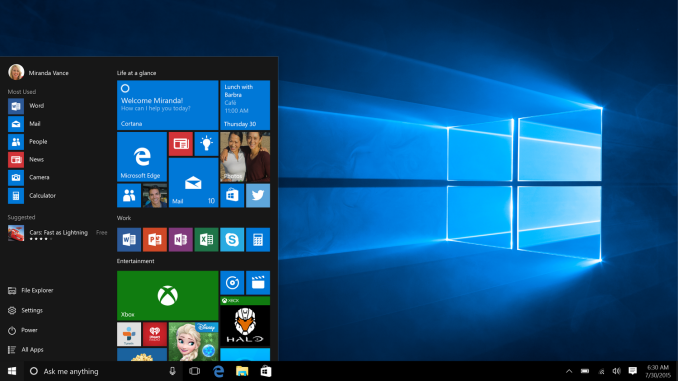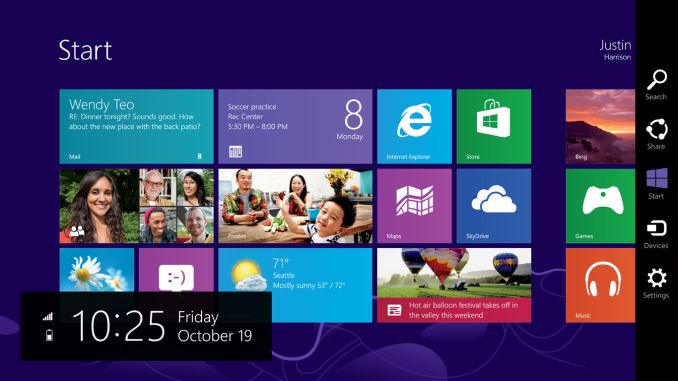The Windows 10 Review: The Old & New Face of Windows
by Brett Howse on August 25, 2015 8:00 AM EST- Posted in
- Operating Systems
- Microsoft
- Windows 10

Let’s flash back to 2012. About three years ago, Windows 8, the last major release of Microsoft’s ubiquitous operating system, was released to manufacturers. This was to be Microsoft’s most ambitious release yet. Traditional PC sales were in decline, and more personal devices such as the iPad tablet were poised to end the dominant PC platform. Microsoft’s response to this was to change Windows more than in any previous release, in a bid to make it usable with the tablet form factor. Windows 8 launched in October 2012 to much fanfare.
There was much fanfare, but little in the way of sales. Yes, Microsoft did sell many copies of Windows 8, but it did not help the declining PC market rebound. Windows 8 came to be with a touch first interface, with a new Start Screen replacing the traditional Start Menu, and a new breed of Windows 8 apps, which run on the WinRT framework. These WinRT apps have been named many things over the past three years, starting with Metro apps. A trademark dispute ended that naming scheme though, and over time they have morphed from full screen apps to universal apps to Windows Store apps, and practically none of them were able to rival the older Win32 platform in popularity or productivity.
Windows 8 did bring some great features to Windows, but they were overshadowed by the major design shift which, while good as a touch based operating system, alienated many who still used Windows on a traditional desktop or notebook. The Start Screen was a big turn off to many people, and full screen apps were not very efficient on a large screen display. Even the multitasking in Windows 8 was less than ideal, with the initial release only allowing two Windows Store apps to be open at any one time, and the second was relegated to a small side bar.
Microsoft’s own faith in Windows 8 was clearly not strong. Only a couple of weeks after Windows 8 launched, they unceremoniously dumped the project head Steven Sinofsky from the company, and spent the next two years trying to make Windows 8 more usable on traditional mouse and keyboard type machines, which were the vast majority of Windows devices in the hands of users. Windows 8.1 arrived and fixed some of the key issues with Windows 8, and 8.1 Update launched with the ability to boot to the desktop, and avoid the touch interface almost completely if you wanted to.
 Windows 10 Start Menu and Desktop view
Windows 10 Start Menu and Desktop view
When looking at Windows 10, I think it is pretty important to look back over the last three years, because none of this is ever built or designed in a vacuum. Microsoft has a huge number of devices running Windows, but a large majority of them are running Windows 7, which was an evolutionary desktop upgrade. Windows 8 struggled to ever take over any of that usage share. Windows 10 is Microsoft’s attempt to bridge the divide. Windows 7 is used by hundreds of millions of people, but its touch support is practically zero. Windows 8 works well in a touch scenario, but is not ideal for keyboard and mouse based devices. Windows 10 promises to be the version of Windows which bridges this gap.
Windows 10 brings about as much change as Windows 8 did, but in almost all cases it is going to be appreciated by users rather than avoided. It will run on a dizzying number of device types, including the traditional desktop, notebook, tablet, two-in-one, phone, IoT, Raspberry Pi, Hololens, Surface Hub, and even Xbox One. What it will bring to each of those device types is not the single interface that Windows 8 pushed on the desktop, but a unified app platform. Each device type will have its own interface, but the underlying app platform will allow developers to target a huge number of devices. And developer buy-in is the one thing Microsoft needs more than any other in order to make this vision succeed. For all of Windows 8’s quirks, it was really the lack of quality apps in the Windows Store which was the one hurdle Microsoft could not code around. Only time will tell whether or not the new model succeeds where the old one failed, but at the beginning of the life of Windows 10 we can go through all aspects of it and see what’s new, what’s changed, and how it fits in on today’s devices.











293 Comments
View All Comments
wavetrex - Tuesday, August 25, 2015 - link
*Installs Windows 13* Oh look, nice, shiny ! DirectX 15... Awesome VR games ... HELL YEA !Next day, two guys with a Microsoft logo on their uniforms ring the door:
- Yes ?
- We're from Microsoft, we're here to install these cameras in your apartment as part of your yesterday Free Windows 13 package.
- Oh, ok.
Guys finish, all the nice cameras are in every room with a bright red dot on them; They leave.
- Eh... bye?
*Goes back to gaming*
Next day the doorbel, a woman and a man, with a Microsoft logo on their shoulder.
- Yes?
- We're from Microsoft, we're here to install here these microphones, movement sensors and the freshly new smell detectors, as part of your Free Windows 13 package.
- Errr... ok ? Are they needed ?
- Of course sir, it's standard procedure for Windows 13 !
- Well, carry on.
The people finish, there's all sorts of gadgets in every room, stuff glued to the wall, ceiling; They leave.
*Thinks: Well, they must be needed. Back to gaming!*
In the weekend, two hot nurses ring the door.
- Hee... loo ?
- Hi there, we're here to take a blood sample, urine sample, and do some tests on you, as part of your Free Windows 13 package.
- Seriously?
- Yes, everyone installing Windows 13 has to do it, standard procedure !
- Uh... well, if it's standard...
The girls take all the samples they need; Leave
*Damn, I didn't new about this stuff... I wonder what they do with it*
Next week, two big men ring the door.
*Afraid to open, I ask loudly: YES??
- Sir, you have to come with us. We're from Microsoft and we have decided that you need to be plugged into the Matrix as part of your Free Windows 13 package.
- Plug into... what ?
- OPEN THE DOOR or we'll open it for you.
*Faints*
----
Seriously, when do we draw the line?
prophet001 - Tuesday, August 25, 2015 - link
We should have drawn it a long time ago.At the least we should draw it here.
BillyONeal - Tuesday, August 25, 2015 - link
I think you need to pay attention to these: https://yourlogicalfallacyis.com/slippery-slope https://yourlogicalfallacyis.com/strawmanExodite - Tuesday, August 25, 2015 - link
To be fair Slippery Slope is only a fallacy if you can't make a compelling argument for why it should apply.Microsoft's track record should suffice I'd say.
Besides, a little hyperbole can help illustrating the point!
wavetrex - Tuesday, August 25, 2015 - link
The story is obviously a joke...But still, if you would tell to someone in 1998 who installs Win 98 for the first time and enjoys his IE3/4 and Netscape websites that the operating system in 2015 will send pretty much everything to do to MS for analysis and "improving user experience" they would call you insane...
(and probably say something like: The government won't allow that !!)
Have you heard about the concept of the Boiling Frog ?
Oxford Guy - Tuesday, August 25, 2015 - link
Typical people would say insane. Others know that, since the purpose of law and government is to maintain elite privilege, the more connected people are, the more their privacy will be diminished.Information is power. People in power want to maintain their power and expand it. So, they will make a big deal of Hillary Clinton having "classified e-mail" but act as if the masses should not expect any privacy. So many IT sites have declared privacy dead and have long said only fools think e-mail is private and yet the government clearly thinks it deserves the right to have private e-mail.
boeush - Tuesday, August 25, 2015 - link
That was amazing! You should be writing skits for SNL or the Comedy Channel. Seriously!Nibholm - Tuesday, August 25, 2015 - link
Nice lifestyle article with few lazy canned tests. I would expect tech site to have even small tests to see difference between wddm 1.x and 2, universal apps vs win32 and so on... Also why use only windows 8 as comparison base, 7 would be much more relevant.looncraz - Tuesday, August 25, 2015 - link
Windows 10 is an improvement over 8, sure, but it is still not as good as 7 for the desktop - but I think they can get there.Things they need:
NO flat aesthetics! It's like moving to Windows 1.0, not 10.0.
Simple application search in start menu - when I search, I don't get any of my apps - when I turned off web results, I didn't get any useful results!
There's no easy way to add the computer icon to the desktop (10 calls it "This PC," of course, for no reason).
The ability to select the types of updates to allow and to disable them easily.
---I can disable them entirely by setting the network connection to metered, or disabling the service, but neither are ideal options.
Things I like:
Multiple desktops (FINALLY!) Not only that, it is quite a nice implementation!
Yeah, that's about it. I spent quite some time trying to think of something I like better in 10... maybe DX12 will be a killer feature for it? Time will tell.
wavetrex - Tuesday, August 25, 2015 - link
You are not alone...Feels like 1 step forward, and a mile run back... Win 10 looks worse than '95 . No joke :(